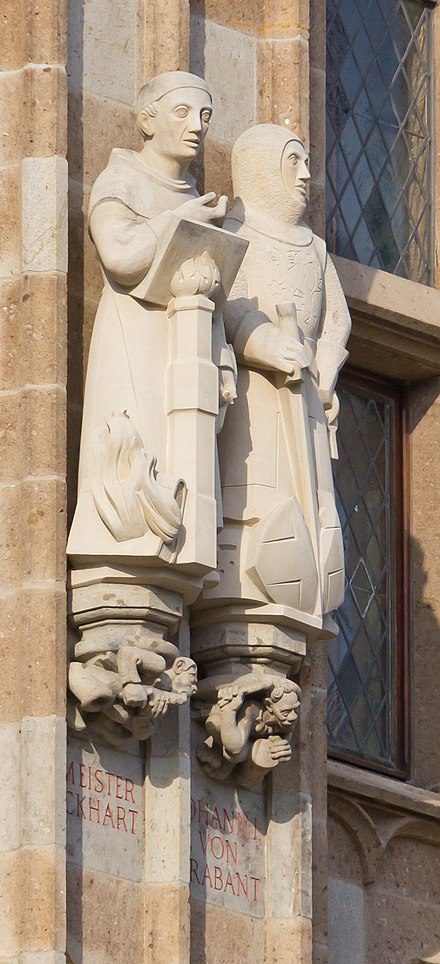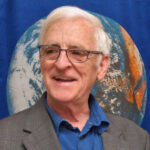
By Larry Joseph Calloway (c)
Contemplare et contemplata aliis tradere (to contemplate and hand on to others the fruits of contemplation) – Motto of the Dominican order of Catholic friars.
NEUROSCIENCE can correlate electronic images of brain activity with various expressions of mindfulness, but there is no science of meditation — no experimentally verified instruction on how to meditate, so far as I know. Meditation is cultural. It’s spiritual. It’s religious. Yogins advise physical poses and pray stilling the business of the mind. Zen lamas say, “Just sit.” Transcendental Meditation teachers guide you to a evocative personal mantra. Psychiatrists prescribe drugs. Trip therapists administer mushrooms. Biofeedback technicians wire you for sound (which is just another kind of image). Seven centuries ago, a Dominican preacher called Meister Eckhart – investigated for heresy in his time and studied for introspective guidance in ours – preached against images.
He lived (1260-1328) in the era called High Medieval, characterized by Gothic architecture reaching toward heaven like the soaring cathedral at Cologne, from where he preached and administered female convents. He earned the honorific “Master” at the University of Paris. Texts of his German vernacular sermons tell allegorical stories with creative, sometimes erotic, symbolism. I will discuss two of his stories: about Martha and Mary at the Bethany citadel and about Jesus at the Temple in Jerusalem. Together these allegories introduced Eckhart’s strange lessons of detachment, the “naked God,” the “virgin wife,” and – most instructive for today’s meditators – “alien images.”
 A History of Western Philosophy by Bertrand Russell, reprinted endlessly since 1945, bears only a one-sentence mention of Eckhart. By contrast, in 2023, the Stanford Encyclopedia of Philosophy published a brand new, 15,000-word entry on Eckhart with a five-page current bibliography.
A History of Western Philosophy by Bertrand Russell, reprinted endlessly since 1945, bears only a one-sentence mention of Eckhart. By contrast, in 2023, the Stanford Encyclopedia of Philosophy published a brand new, 15,000-word entry on Eckhart with a five-page current bibliography.
The article’s scholarly writer, Amber Griffioen of the Duke faculty, (whose personal web site emphasizes she’s a wife, mother and baseball fan) testifies that Eckhart has become “wildly popular in non-academic circles.” She remarks that the disordered registry of his German works and the lack of a complete edition of his Latin works are due to “neglect in philosophic circles to Eckhart’s intellectual contributions to the history of philosophy.” The continuing neglect has to do with the disparagement of mysticism. “Eckhart’s modern reception as a mystic is unfortunately also due to entrenched scholarly biases, both past and present, against Medieval vernacular spiritual and theological writing,” she begins in the Stanford entry.
My reading of Eckhart sermons shows that he followed some standard metaphysical doctrines adapted from Greek classics: the earth-centered cosmos of concentric spheres – “Since the heavens revolve, day comes with the first revolution of the heavens,” he said. (DW10) – and Aristotle’s teleology of the Unmoved Mover – “a simple stillness which is immovable in itself.” (DW48). He also honored the principle of plenitude: that all possible things are created, including the chain of being from heaven to earth. Still, in his late sixties he was tried at Cologne for heresy by a commission of the French papacy at Avignon (Rome having been temporarily vacated). He was a respected elder of the Church, which must have contributed to his acquittal. Also, he offered to retract any theological errors. (His possible friend and influencer, Marguerite Porete refused to recant her writing and was burned at the state in 1310.) Eckhart died in January 1328 awaiting appeal to the pope of the findings of the commission that declared 28 of his propositions to be as “heretical as the words sound.” Pope John XXII in March 1329 issued a bull upholding the commission and ordering the propositions to be published in Cologne so that, “the hearts of the simple. . . may not be filled with the errors contained in them.”
Griffieon says the wording indicates that members of the commission “were inclined to take the propositions literally and out of context despite Eckhart’s protestations that he had been misunderstood.”
The Virgin Wife
In Luke 10:38-42 Jesus is welcomed by Martha whose sister Mary falls to his feet to hear his words as Martha goes to work elsewhere in the house. Soon, the Scripture says, Martha complained about Mary not helping her. Jesus responds, “Martha, Martha you are fretting and fussing about so many things; only one thing is necessary. Mary has chosen what is best.”
 Matthew Fox, among the Christian writers who depict Eckhart as a mystic, says his sermon (DW2) on the verse “totally turns upside down the traditional interpretation, repeated ever since St. Augustine, that the story illustrates the superiority of the contemplative life over the active life.”
Matthew Fox, among the Christian writers who depict Eckhart as a mystic, says his sermon (DW2) on the verse “totally turns upside down the traditional interpretation, repeated ever since St. Augustine, that the story illustrates the superiority of the contemplative life over the active life.”
Eckhart begins with the citation, which is traditional, reading in Latin. He then translates: “Our Lord Jesus Christ entered a citadel and was received by a virgin who was a wife.” The actual Scripture does not mention “virgin” or “wife.”
“Now note,” Eckhart said, “the fact that it has to be a ‘virgin’ who receives him.” (One translator remarks that “received” and “conceived” are synonymous in Medieval German.) And Eckhart says Mary had “an inexpressible desire: she was filled with desire, but did not know why.”
His commentary later favored Martha. More mature than her infatuated sister, she could work and contemplate at the same time. Martha was skilled in the required hospitality. She knew how to do “what love commands,” without falling in love. The preacher suggested her request for help was not said grudgingly but in good will or even with affectionate teasing.
Mary may have had a virgin mentality, which was necessary but not sufficient to receive (conceive) Eckhart’s Jesus. Martha had it too, but she delivered when Mary, in her passion, could not. Eckhart supposed that Martha had a husband and that together they were “fruitful.” He said, “Wife is the noblest name that can be applied to the soul and it is more excellent than ‘virgin.’” Martha was both. And so, he calls her a “virgin wife.” The implicit biblical reference for “virgin wife,” of course, is Mary of Nazareth, who had immaculately conceived Jesus when she married the obscure tradesman Joseph.
Strangeness
Eckhart’s definition of “virgin” was “someone who is free of all alien images (bilden).” The reference is not to physical images such as statues or fresco portraits. It is what the Oxford English Dictionary defines as “a mental representation of something (esp. a visual object) not by direct perception, but by the memory or imagination.” As the parenthetical note
suggests, a mental image does not have to be visual. It may be a representation of something heard or something perceived by other senses.
Frank Tobin, author of the authoritative 1986 book Meister Eckhart: Thought and Language, was perplexed by the preacher’s frequent use of bilden or bilde. Among more familiar terms in Eckhart’s communications, this one, Tobin wrote, “is really puzzling and the one causing the others to retain a certain unfocused character.” And, “It is this term bilde, as something to be eliminated, that takes Eckhart’s thoughts beyond the usual ascetical dimensions of detachment and gives them a more metaphysical flavor. Its exact meaning is difficult to grasp.”
Detachment, mentioned by Tobin, is a key value in Eckhart’s sermons. “When I preach, I am accustomed to talk about detachment, saying that we should become free of our selves and of all things,” Eckhart said (DW53). Evidently, Tobin recognized that the preacher’s critique of “images” had to do only with cognitive activity, not behavior in the world. So, Tobin’s perplexity might have been based on his perception that Eckhart was telling people: “Stop thinking!”
This happens to be a popular admonition today in the West. Alan Watts, who helped popularize Zen in the American Sixties, frequently pops up on the internet saying: “A person who thinks all the time has nothing to think about except thoughts. So, he loses touch with reality, and lives in a world of illusions. By thoughts, I mean specifically, chatter in the skull. Perpetual and compulsive repetition of words, or reckoning and calculating.”
That opinion of “thinking” devalues the academic discipline of epistemology (the study of knowledge) but what Watts meant by thoughts can be identified with what Eckhart meant by bilden. The preacher had refined the experience of cognition in a way that distinguished “images” from “thoughts.” It is important that Eckhart did not sort good images from bad images. All images are “alien” – strangers in the strange vision where soul and God are the same Substance. Non-divine images belong to the world of creatures, or in my understanding, the continually created.
The Doves
This indiscriminate alienation of all images is illustrated in Eckhart’s allegorical interpretation of the Gospel story in which Jesus and his followers raid the Jerusalem Temple. Of the three Gospel accounts, Eckhart chose Matthew 21:12, which says, “And Jesus went into the temple of God, and cast out all them that sold and bought in the temple, and overthrew the tables of the money changers, and the seats of them that sold doves.” Let me quote a long sermon passage (DW1) to give a flavor of Eckhart’s style:
“Now take note! Who were the people who were buying and selling, and who are they now? Listen carefully. I wish to speak only of good people in this sermon, but I shall just indicate who these traders were and are, these people who were buying and selling, and who our Lord drove out. And our Lord still does drive out all those who buy and sell in his temple, not allowing a single one to remain. Now see, those people are all traders who refrain from serious sin, who wish to be good people and who do good works for the glory of God such as fasting, keeping vigil, praying and the like, all good works, and yet they do them in order that our Lord should give them something in return or do something for them which they desire: in other words, these people are all merchants. These are very foolish people who wish to barter with God, and they know little or nothing of the truth. That is why our Lord drove them out of the temple. The light and the darkness cannot exist together in the same place.”
The Temple is our soul. All images – good or bad – are hindrances to the work of achieving the seamless unity of the “spark” of the soul with the sublime light of the Divine. The doves and their sellers are an illustration of this. They are good, but there are no exceptions in cleansing the Temple (or the soul). Jesus “did not drive them out nor did he berate them severely but said quite gently: ‘Take these things away,’ as if he wished to say: ‘These are not evil in themselves but nevertheless they stand in the way of the purest truth,’” Eckhart said.
“The prophets who walked in light,” he said, “recognized and found the hidden truth under the influence of the Holy Spirit. . . but they were struck dumb and could not speak. . .The images in their minds were all wholly unlike what they saw in God and were such a travesty of the truth that they preferred silence to lies.”
Again, the images in their minds were representations of what can be perceived in the created world, among creatures. The thought of the Divine was of an entirely different category. So, the message to the New Age would be: discard images and let the thoughts be.
Two Gods
Eckhart said, “I ask God to make me free of ‘God.’” (DW52) There are two Gods in that sentence. To start with, the second one, in quotes (as translated by Oliver Davies), is the God of images – ordinary images or extraordinary images like Michelangelo’s depiction of the Creator in the Sistine Chapel. The Renaissance artist’s God is naked under a transparent sheath, suggestive of Eckhart’s sermon two centuries earlier. Using imagery as ironically he was inclined to do, Eckhart advocated stripping down the imaginary God to “pure and clear Substance.” He said, “Strip away from God therefore everything which clothes him and take him in his dressing room where he is naked and bare in himself.” (DW40) Stripped, naked, bare. . .empty. “God is a word, an unspoken word,” Eckhart said. Amber Griffieon comments that Eckhart’s God is “the divine nothing, a kind of nothingness, or better, no-thing-ness.”
The first God in that sentence is of the Light that Eckhart often preached. The way to “dwell in him,” begins with detachment. Eckhart said, “When we turn away from ourselves and from all created things, to that extent we are united and sanctified in the soul’s spark, which is untouched by either space or time. This spark is opposed to all creatures and desires nothing but God, naked, just as he is in himself. He is not satisfied with the Father, the Son or the Holy Spirit, nor with the three Persons together as far as each exists in their particularity.”
There is more to the experience behind the imagery, of course. “I have said often enough that there is a power in the soul which is untouched by either time or flesh. It flows from the spirit and remains within the spirit and is entirely spiritual by nature,” Eckhart said. And, “Sometimes I have said that there is a power in the soul that can alone be said to be free. Sometimes I have said that it is a refuge of the spirit and sometimes I have said that it is a light of the spirit. Sometimes I have said that it is a spark. But now I say that it is neither this nor that, and yet still it is something that is as far above this or that as heaven is above the earth.”
So, what if, in our post-modern era of scientific thinking, you simply don’t believe in the orthodox Christian God? Eckhart’s theory of discarding images still stands. By recognizing them, and letting go of them in meditation we can perhaps approach Eckhart’s religious experience.
Or can we without the gift of grace? In Eckhart’s sermon DW5 the “the poor in spirit” are blessed without any effort of their own. In their inner spirit of detachment, they know nothing, want nothing and have nothing. In the outer world as it exists today, the poor in spirit would not be affected by the storm of images of things to need or want or to protect from losing. In the post-modern world of science-based polling, we are bound by advertising images – by a pornography of fast foods, vehicles, beers, insurance, shows, sports, celebrity stars, etc.
Griffieon says, “According to Eckhart, God should not — indeed, cannot — be sought in such ‘special ways’ (his phrase) as devotion, prayer, meditation, good works, or even divinely inspired religious ecstasy.” With reference to Eckhart, she says, “When we give ourselves wholly over to God, and the Word is born in the ground of our souls, God will simply act through us, such that our actions are God’s actions and therefor performed simply for their own sake without some further ‘why’ or ‘wherefore.’” I regard this as Christian orthodoxy that should not have drawn the attention of a papal inquisition.
Yet, as Tobin wrote, “Eckhart ran afoul of the authorities, perhaps primarily because of his frequent claims of the utter identity of God and the soul. If he meant this in an absolute sense, with no qualifications or conditions whatsoever, the judgements of the church authorities are hardly to be questioned. Such identity does not conform to traditional Christian teachings.”
The philosopher Spinoza at the 17th century rise of science asserted there is but one Substance (called God, or Nature) and “Whatever is, is in God.” He said, “All things are made through the power of God. Because the power of nature is nothing but the power of God itself it is certain that insofar as we are ignorant of natural causes, we do not understand God’s power.” My belief is that the fundamental causation, against the ground of chaos, is the continuous creation and speciation of discrete entities, from galaxies to electrons. What if we consider Eckhart’s “images” as discrete entities like frames in movie film or videos? The motion in these motion pictures is a projection of our own minds. In other words, it is consciousness that creates continuity. The observer affects what is observed.
We are generally free of inquisitors into how we live and think, although their recurrence is a threat, so we can meditate as we wish, even using hallucinogens. Or we don’t have to do anything spiritual. We can indulge in images, welcome them when and if we want to, as in Rumi’s poem about images:
The Guest House
This being human is a guest house.
Every morning a new arrival.
A joy, a depression, a meanness,
some momentary awareness comes
as an unexpected visitor.
Welcome and entertain them all!
Even if they’re a crowd of sorrows,
who violently sweep your house
empty of its furniture,
still, treat each guest honorably.
He may be clearing you out
for some new delight.
The dark thought, the shame, the malice,
meet them at the door laughing,
and invite them in.
Be grateful for whoever comes,
because each has been sent
as a guide from beyond
Yes, we can let the guests come in one door and go out the window as we find stillness in meditation.
